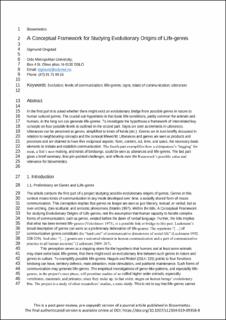A Conceptual Framework for Studying Evolutionary Origins of Life-Genres
| dc.contributor.author | Ongstad, Sigmund | |
| dc.date.accessioned | 2022-01-18T13:44:16Z | |
| dc.date.available | 2022-01-18T13:44:16Z | |
| dc.date.created | 2019-05-10T09:11:05Z | |
| dc.date.issued | 2019-05-04 | |
| dc.identifier.citation | Biosemiotics. 2019, 1-22. | en_US |
| dc.identifier.issn | 1875-1342 | |
| dc.identifier.issn | 1875-1350 | |
| dc.identifier.uri | https://hdl.handle.net/11250/2837997 | |
| dc.description.abstract | The introduction claims that there might exist an evolutionary bridge from possible genres in nature to human cultural genres. A sub-hypothesis is that basic life-conditions, partly common for animals and humans, in the long run can generate so-called life-genres. To investigate such hypotheses a framework of interrelated key communicational concepts is outlined in the second, main part. Four levels are suggested. Signs are seen as elements in utterances. Further, sufficiently similar utterances can be perceived as kinds of utterances or genres. Genres are kinds of communication in a species' life-world. Utterance and genre are the framework’s key concepts. Both are seen as products and processes and as constituted by five reciprocal aspects: form, content, act, time, and space, the necessary elements to initiate and interpret communication. A model illustrates this integrative principle. Part three dwells with the idea of life-genres, and part four exemplifies and problematises how a chimpanzee’s ‘begging’ for meat, a fish’s nest-making, and kinds of birdsongs, could be seen as possible life-genres. The last, short part gives a brief summary, highlights challenges, and reflects over the framework’s relevance for biosemiotics. | en_US |
| dc.language.iso | eng | en_US |
| dc.publisher | Springer | en_US |
| dc.relation.ispartofseries | Biosemiotics;12 | |
| dc.subject | Evolution | en_US |
| dc.subject | Communication levels | en_US |
| dc.subject | Life-genres | en_US |
| dc.subject | Signs | en_US |
| dc.subject | Triads of communication | en_US |
| dc.subject | Utterances | en_US |
| dc.subject | Communication theory | en_US |
| dc.title | A Conceptual Framework for Studying Evolutionary Origins of Life-Genres | en_US |
| dc.type | Peer reviewed | en_US |
| dc.type | Journal article | en_US |
| dc.description.version | acceptedVersion | en_US |
| dc.rights.holder | © Springer Nature B.V. 2019 | en_US |
| cristin.ispublished | true | |
| cristin.fulltext | postprint | |
| cristin.qualitycode | 1 | |
| dc.identifier.doi | https://doi.org/10.1007/s12304-019-09358-8 | |
| dc.identifier.cristin | 1696813 | |
| dc.source.journal | Biosemiotics | en_US |
| dc.source.pagenumber | 1-22 | en_US |
Files in this item
This item appears in the following Collection(s)
-
LUI - Institutt for grunnskole- og faglærerutdanning [521]
LUI - Department of Primary and Secondary Teacher Education -
Publikasjoner fra Cristin [3191]
